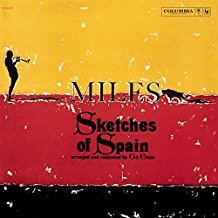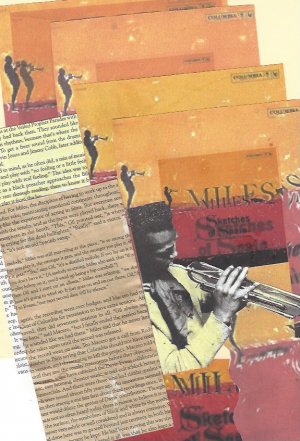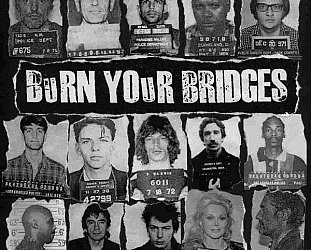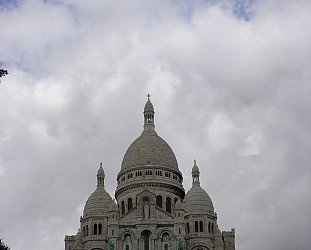Graham Reid | | 5 min read
Song of Our Country (take nine)

When Miles Davis entered Columbia Records’ New York studio in November 1959 with composer/arranger Gil Evans and producer Teo Macero to record the material for the album Sketches of Spain, the trumpeter was not on completely unfamiliar territory.
He had seen and heard flamenco music, doubtless knew the explorations of Spanish music by Lionel Hampton, Charles Mingus and others, had heard a recording of the Spanish composer Joaquin Rodrigo’s Concierto de Aranjuez (one section of which Evans would adapt for him on Sketches) and of course had already recorded Blues for Pablo and Maids of Cadiz on Miles Ahead in ’57 and Flamenco Sketches on Kind of Blue (co-written with Evans, an album produced by Macero) earlier that year.
He had also
previously worked with the perfectionist Evans on two projects: Miles Ahead in
’57 and Porgy and Bess (recorded the year before the first Sketches sessions,
also with producer Macero).
Given all
that, you’d have thought that the recording of Sketches of Spain – another landmark
album in Davis’ career – would have gone smoothly.
The opposite
was true.
Davis
played flugelhorn in some places and Evans’ charts were notoriously complex. Their
first sessions with some classical musicians were fraught and finally
fruitless.
In his
free-wheeling and frequently self-aggradising autobiography Davis was angrily
dismissive of classical musicians: “The musicians can only play what’s there
and nothing else. They can remember and have the ability of robots. In
classical music, if one musician isn’t all the way a robot, like all the rest,
then the other robots make fun of him or her . . .”
Neither Davis nor Evans wanted the robotic playing on such emotional music.
Yet Davis admitted
that he too struggled with the charts where the voicing of his trumpet was to
be akin to playing the guitar part in the Rodriguez piece and a woman’s voice
in Saeta.
Davis said
Evans had to re-orchestrate the Saeta charts and for most of the playing he
(Davis) would read the score over and over, listen to it and only then play it
just a couple of times to capture the feeling of spontaneity and freshness.
Davis also
delayed the subsequent sessions after the aborted hours with classical players until
he could get his favourite lead trombonist Frank Rehak who had been on Miles
Ahead and Porgy and Bess.
Rehak wasn’t
available and Davis refused to do the sessions without him. According to John
Szwed’s So What; The Life of Miles Davis, “In the end, nineteen musicians and
several engineers all had their schedules changed to fit Rehak’s on the date”.
When the sessions
were finally done, Davis said in his autobiography, “I didn’t have nothing
inside me. I was drained of all emotion and I didn’t want to hear that music
after I got through playing all that hard shit”.
He said he
didn’t hear the music again until the album came out the following year and in
his autobiography is casually dismissive of it: “When I finally did hear it, my
musical head was somewhere else, so I didn’t think nothing of it . . . I liked
the record and thought everybody had played well on it and that Gil had arranged
his ass off, but it didn’t have a large impact upon me”.
It had an
impact on composer Rodrigo however, he didn’t like it at all (“Let’s see if he
likes it after he starts getting those royalty cheques,” said Davis) and for
Davis listeners more comfortable with the modal sounds of Kind of Blue of the
same period, it is a more difficult proposition.
 But it
remains a singular album in Davis’ vast catalogue – the very different but also
Spanish-influenced Marcus Miller-produced Siesta decades later suffered in the
comparison – and it has now been reissued at budget price as a double disc with rehearsal
takes, alternate and live versions.
But it
remains a singular album in Davis’ vast catalogue – the very different but also
Spanish-influenced Marcus Miller-produced Siesta decades later suffered in the
comparison – and it has now been reissued at budget price as a double disc with rehearsal
takes, alternate and live versions.
The extra
disc, sensibly, opens with Maids of Cadiz and closes with the classic Davis
quintet of the period – John Coltrane, Wynton Kelly, Paul Chambers and Jimmy
Cobb -- improvising on a nine minute-plus tribute to producer Macero entitled
Teo which was on the Quintet album Someday My Prince Will Come recorded later
in early ‘61. It seems an odd inclusion because – although the argument runs it
was influenced by Sketches – more apposite inclusions might have been Blues for
Pablo and/or Flamenco Sketches. Although you can see the canny marketing logic,
those two are much more familiar given the profile of Kind of Blue in many
people’s collections.
The live
version of the Concierto De Aranjuez on the extra disc is important because it
was the only piece from the original album ever performed before an audience
(Carnegie Hall in May ’61). It is also quite superb and Davis adopts an
especially delicate tone
Most of this
extra material has appeared previously but in expensive box sets or on hard to
find CDs. So to have the original album (plus Evan’s brief but heroic Song of
Our Country from the same sessions with Davis again adopting the Spanish voice
in his playing) and these outtakes and allied material on place is useful,
especially for those coming new to this style of Davis’ playing, the trumpeter
within the context of an orchestra.
The album,
as with those others where Davis worked with Evans, is considered one of the
highpoints of the Third Stream movement where jazz and classical music attempted
to find some common ground, a term used by this album’s liner note writer
Schuller.
Although the
adapted adagio from Rodriguez’ Concierto is considered the centerpiece (albeit
the opening track) there is superb playing by Davis and delightful arrangements
by Evans elsewhere, notably on the 12 minute-plus Solea where Davis plays with
a 22-piece orchestra and, as Gunther Schuller wrote in the liner notes when
this set was originally released in 2009, “unlike the other pieces, it kind of
swings giving it a slightly happier, less melancholy feeling . . . it is also
Miles’ most assured and confident solo excursion”.
That
comment highlights a problem some have always had with this album, that it feels
constrained, the emotions tight and not free flowing, the lack of the rhythm
section being allowed to lay out the tempo so familiar in jazz . . .
Perhaps
Sketches of Spain is a jazz crossover album more to be admired and analysed
than enjoyed?
Perhaps.
But –
despite Davis’ typical dismissal of it, he wanted to present himself as a man
always moving forward – it is an album of considerable pleasures and more than
a few are on the extra disc where you can hear just how fastidious Evans and
Davis wanted to be about it. Among the tracks are two versions of Song of Our
Country – a lovely piece.
One of them, taking the piece at a slightly slower tempo, is take 14.
There is much more on Miles Davis at Elsewhere including an interview, and album and DVD reviews. Start here.
.
Elsewhere occasionally revisits albums -- classics sometimes, but more often oddities or overlooked albums by major artists -- and you can find a number of them starting here







post a comment